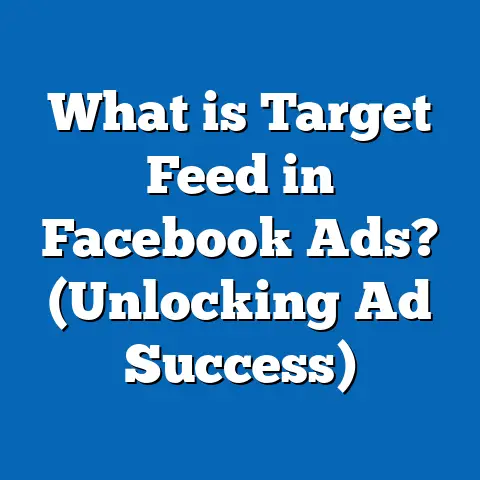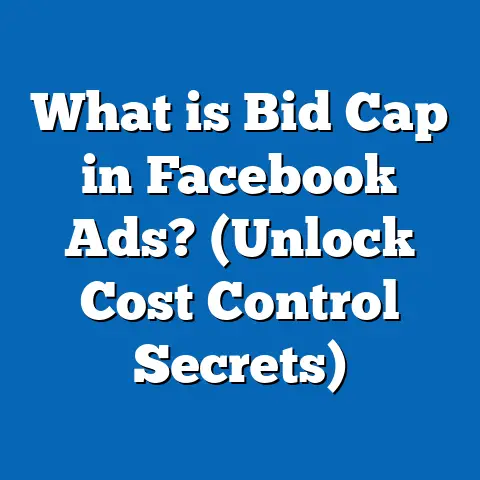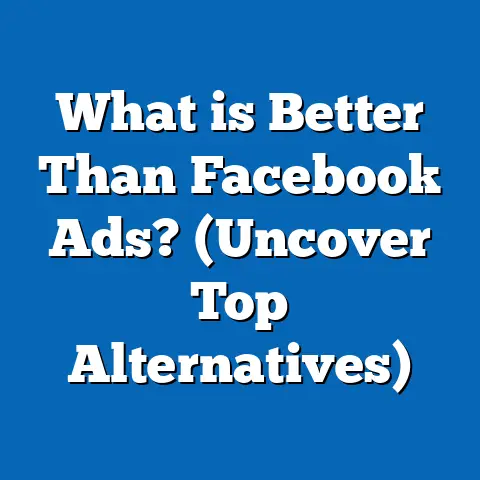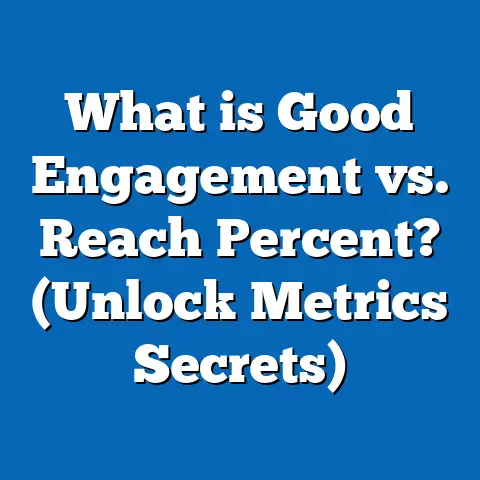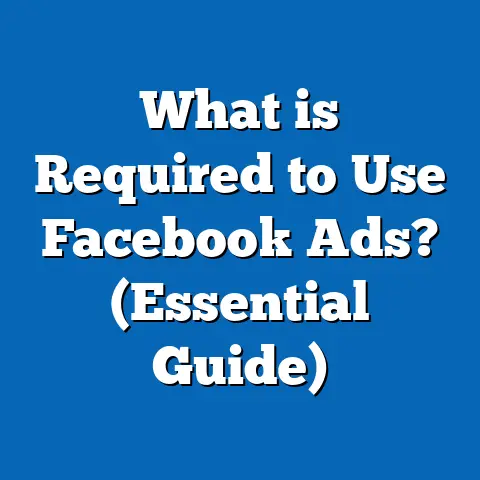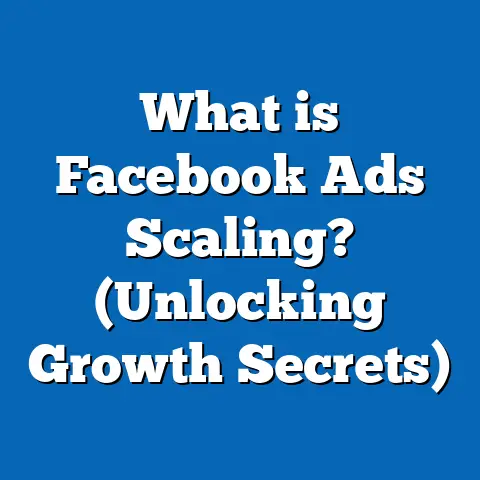What is Facebook Messenger Ads? (Unlocking Engagement Secrets)
What is Facebook Messenger Ads? (Unlocking Engagement Secrets)
Introduction: The Affordability Advantage of Facebook Messenger Ads
Marketing budgets are often tight, especially for startups and small businesses striving to compete in crowded markets. Many digital advertising options demand significant investments for decent returns, creating barriers for smaller players. Enter Facebook Messenger Ads — a cost-effective advertising format that allows brands to engage potential customers directly in a conversational space.
Messenger Ads provide a unique blend of affordability and engagement by enabling businesses to connect personally with users on a platform where people already spend significant time messaging friends and family. This personal interaction fosters trust, encourages user action, and ultimately improves conversion rates without requiring the heavy investment typical of other channels.
This guide offers a deep dive into Facebook Messenger Ads, illustrating how marketers can unlock engagement secrets through this powerful tool. We’ll cover fundamentals, technical setups, advanced strategies, data-backed insights, real-world applications, industry trends, and actionable steps.
Understanding Facebook Messenger Ads
What Are Facebook Messenger Ads?
Facebook Messenger Ads are advertisements designed to initiate or re-engage conversations with users within the Messenger app or from other Facebook-owned platforms like Instagram and Facebook itself.
Unlike traditional static ads appearing in news feeds or sidebars, Messenger Ads invite users to start a chat with a business. This conversational approach shifts marketing from one-way broadcasting to two-way interaction.
There are three main types:
- Click-to-Messenger Ads: Users click an ad and are directed to a Messenger chat.
- Sponsored Messages: Businesses send promotional messages to users who have previously interacted with them on Messenger.
- Messenger Inbox Ads: Ads appear directly within the Messenger app’s inbox as sponsored conversations.
How Do Facebook Messenger Ads Work?
When a user clicks a Messenger Ad or receives a Sponsored Message, they enter a chat interface with the brand. This can be managed live by customer service agents or automatically by chatbots programmed to provide instant responses.
The goal is to engage users in personalized conversations that drive sales, lead generation, customer support, or brand awareness.
The Evolution of Conversational Advertising
Before diving deeper into Messenger Ads, it’s important to understand conversational advertising’s evolution:
- Traditional display ads relied on passive viewing.
- Email marketing introduced direct communication but suffered low open rates.
- Social media ads increased targeting precision but remained largely one-directional.
- Messaging apps like Facebook Messenger introduced real-time, two-way communication channels.
- Advances in chatbot technology made scalable conversational marketing possible.
Today’s Messenger Ads represent the maturity of this trend, combining targeted reach with immediate engagement.
Why Choose Facebook Messenger Ads? Key Benefits Explained
1. Cost-Effectiveness Compared to Other Platforms
Advertising on Facebook Messenger generally costs less than News Feed or Instagram feed ads. According to WordStream, average CPC for Messenger Ads sits between $0.10 and $0.30, compared to $0.97 for Facebook News Feed ads.
This cost difference arises because:
- Messenger Ads target users in a less saturated environment.
- The personal nature of conversations leads to higher engagement.
- Automation reduces manual labor costs.
2. Exceptional Engagement Rates
Messenger messages enjoy open rates up to 80%, vastly outpacing email marketing averages (~20%). This means more eyes on your message and more chances for interaction.
MobileMonkey’s research confirms click-through rates (CTR) for Messenger campaigns can be 3-5 times higher than display ads.
3. Personalized Customer Interaction
Messenger allows brands to tailor interactions based on user data and conversation history. Personalized messages are proven to increase conversion likelihood by 20%-30% according to Epsilon.
4. Automation and Scalability Through Chatbots
Chatbots integrated into Messenger Ads can automate initial responses, qualify leads, recommend products, and even complete transactions — all without human intervention.
A Business Insider report states companies using chatbots on Messenger saw lead qualification times drop by 60%, boosting efficiency.
5. Multi-Purpose Use Cases
Messenger Ads fit various marketing goals:
- Lead generation
- Customer service
- E-commerce sales
- Event promotion
- Feedback collection
Types of Facebook Messenger Ads: Detailed Breakdown
Click-to-Messenger Ads
These are the most common type of Messenger Ad. They appear within Facebook’s News Feed or Instagram feeds as standard ads with a “Send Message” button.
How they work:
- User clicks “Send Message.”
- A chatbot or live agent greets the user in Messenger.
- Conversation flows based on user inputs or scripted chatbot paths.
Ideal for:
- Answering product queries instantly.
- Collecting leads via conversational forms.
- Driving event registrations with reminders through Messenger.
Example:
A cosmetics brand ran Click-to-Messenger ads during a product launch. Users could ask questions about shades and ingredients directly via chatbots, increasing purchase intent by 45%.
Sponsored Messages
Sponsored Messages let businesses send promotional texts directly to people who have already messaged them on Messenger — essentially retargeting.
Key points:
- Not cold outreach—only sent to users who opted in by messaging before.
- Used for upselling, re-engagement, or exclusive offers.
- Can include rich media like images or carousels.
Use case:
An online course provider used Sponsored Messages to send discount codes to past customers who completed free trials. The campaign boosted sales by 25% during the promotion period.
Messenger Inbox Ads
These ads appear as sponsored conversations inside the user’s Messenger inbox alongside regular chats.
Advantages:
- High visibility due to placement among personal messages.
- Natural discovery as users scroll through their chats.
Challenges:
- Requires compelling copy to avoid being ignored or marked as spam.
Best suited for:
Brand awareness campaigns targeting active Messenger users within specific demographics.
Deep Dive into Data: Performance & Statistics of Messenger Ads
| Metric | Statistic | Source |
|---|---|---|
| Monthly Active Users (Messenger) | Over 1.3 billion | Statista 2024 |
| Average CPC (Messenger Ads) | $0.10 – $0.30 | WordStream |
| Average CPC (Facebook News Feed) | $0.97 | WordStream |
| Open Rate (Messenger messages) | Up to 80% | MobileMonkey |
| Email Open Rate | 20% | Mailchimp |
| Average Response Time (Businesses) | Within 10 hours | Facebook Business |
| Conversion Rate Increase Using Messenger Ads | Up to +50% | HubSpot |
| ROI Increase with Chatbots | 30%-40% | Business Insider |
These figures illustrate that Messenger Ads offer highly cost-efficient engagement compared to traditional digital channels.
Technical Aspects: How To Set Up Facebook Messenger Ad Campaigns Step-by-Step
Step 1: Choose Campaign Objective
In Facebook Ads Manager:
- Select “Messages” as your campaign objective.
- This optimizes your ad delivery for messaging interactions.
Step 2: Define Your Audience
Use Facebook’s advanced targeting tools:
- Demographics (age, gender, location)
- Interests and behaviors
- Custom Audiences (website visitors, email lists)
- Lookalike Audiences for expanding reach
Step 3: Select Placement
Choose where your ads will appear:
- Automatic Placements recommended for efficiency.
- You can manually select News Feed, Instagram Feed, Messenger Inbox, etc.
Step 4: Create Your Ad Creative
Develop compelling visuals or videos that attract attention.
Tips:
- Use high-quality images relevant to your offer.
- Keep copy concise with clear CTAs like “Send Message.”
Step 5: Design Your Message Template or Chatbot Flow
Set up automated welcome messages or question flows.
Options include:
- Greeting users and asking qualifying questions.
- Offering product recommendations based on responses.
- Collecting contact details for follow-up.
Tools like ManyChat or Chatfuel integrate easily here.
Step 6: Launch & Monitor Campaign Performance
Track key metrics such as:
- Click-through rate (CTR)
- Number of conversations started
- Message open rates
- Conversion events (sales, sign-ups)
Adjust targeting or creative based on data insights.
How Chatbots Enhance Facebook Messenger Ads
What Are Chatbots?
Chatbots are AI-powered programs that simulate human conversation via text. In the context of Messenger ads, they help automate interactions at scale without needing human agents available 24/7.
Example Chatbot Functions:
| Function | Description |
|---|---|
| Instant FAQ Responses | Answers common user questions instantly |
| Lead Qualification | Asks qualifying questions to identify serious buyers |
| Product Recommendations | Suggests items based on user preferences |
| Booking & Scheduling | Allows appointment booking without human input |
| Order Tracking | Provides status updates on shipments |
Setting Up Chatbots
Marketing teams often use third-party platforms like:
- ManyChat
- Chatfuel
- MobileMonkey
These platforms provide visual flow builders requiring no coding skills but allow advanced customization if desired.
Examples & Case Studies: Real Brands Using Facebook Messenger Ads Successfully
Case Study 1: Fashion Retailer Boosts Sales by 35%
Background: Mid-sized retailer launching a new seasonal collection.
Strategy: Click-to-Messenger ads with chatbot product guides helped users find suitable styles based on preferences input through chat.
Results: Sales increased by 35% in three months; average chat session duration was five minutes indicating strong engagement.
Case Study 2: Local Restaurant Drives Reservations Up by 20%
Background: Neighborhood restaurant struggling with off-peak bookings.
Strategy: Sponsored Messages sent exclusive discount codes and reminders only to past customers who had contacted them via Messenger before.
Results: Reservations rose by 20% within four weeks; repeat visits also increased due to personalized offers.
Case Study 3: SaaS Company Improves Lead Qualification Efficiency by 50%
Background: Software provider with long sales cycles needed better lead filtering.
Strategy: Automated chatbot filtered inbound leads asking about budget and timeline before passing qualified prospects to sales reps.
Results: Lead qualification time decreased by half; sales team focused efforts on higher-quality leads improving closing rates.
Comparing Facebook Messenger Ads With Other Messaging Platforms’ Advertising Solutions
| Feature | Facebook Messenger Ads | WhatsApp Business Ads | Instagram Direct Ads |
|---|---|---|---|
| Monthly Active Users | Over 1.3 Billion | Over 2 Billion | Over 2 Billion |
| Cost Per Click | $0.10 – $0.30 | Generally higher CPC | Similar cost to Facebook |
| Automation & Chatbot Support | Advanced chatbot integration | Limited automation | Limited automation |
| Audience Targeting | Detailed via Facebook Ads Manager | Limited targeting options | Detailed via Facebook Ads Manager |
| Engagement Rates | Up to 80% open rates | High but less documented | Moderate open rates |
| Supported Ad Formats | Click-to-Messenger, Sponsored Messages, Inbox Ads | Message-based promotions only | Story ads with swipe-up CTA |
Advanced Strategies for Optimizing Your Facebook Messenger Ad Campaigns
Use Dynamic Product Messaging
Integrate your product catalog with Messenger chatbots. When users inquire about products, provide tailored recommendations dynamically based on browsing behavior tracked through Facebook Pixel or CRM data integration.
Implement A/B Testing Systematically
Test variables like:
- Message tone (formal vs casual)
- Visual creative (images vs videos)
- Call-to-action wording (“Send Message” vs “Chat Now”)
This helps identify which elements drive higher engagement and conversions.
Leverage Sponsored Messages for Retargeting Warm Leads
Users who interacted but didn’t convert can be re-engaged through Sponsored Messages offering limited-time discounts or additional information addressing objections.
Optimize Chatbot Flows Using Natural Language Processing (NLP)
More sophisticated chatbots use NLP technology allowing them to understand user input more naturally rather than relying solely on button clicks or pre-set replies. This increases user satisfaction and reduces drop-offs during conversation.
Industry Trends Shaping the Future of Facebook Messenger Advertising
AI-Powered Personalization at Scale
Advancements in machine learning enable hyper-personalized messaging tailored in real-time based on user behavior and preferences.
Integration with Augmented Reality (AR)
Brands will increasingly incorporate AR try-ons or interactive experiences inside Messenger chats — e.g., virtually trying on glasses or makeup products before buying.
Unified Messaging Across Platforms
Facebook is working towards tighter integration between Messenger, Instagram Direct, and WhatsApp messaging services allowing marketers to run cross-platform conversational campaigns seamlessly.
Enhanced Privacy & Compliance Standards
With rising privacy concerns globally (GDPR, CCPA), businesses must ensure transparent data use policies and user consent within message-based marketing campaigns.
Practical Implementation Checklist for Marketers & Business Owners
- Define Clear Objectives: Decide whether your goal is lead generation, sales, support, or brand awareness.
- Segment Your Audience Precisely: Use detailed targeting for higher relevance.
- Craft Engaging Creative & Copy: Use eye-catching visuals and compelling CTAs that invite conversation.
- Build Conversational Flows: Design chatbot dialogues that feel natural and guide users smoothly toward conversion.
- Automate Wisely: Balance chatbot use with live agent support for complex queries.
- Test & Analyze: Continuously A/B test elements and monitor KPIs like CTR, open rates, response times, and ROI.
- Retarget Effectively: Use Sponsored Messages to nurture warm leads.
- Stay Updated: Follow platform changes and privacy regulations continuously.
- Invest in Training: Educate your team on best practices in conversational marketing and chatbot management.
- Scale Gradually: Start small with pilot campaigns before expanding budgets based on performance data.
Summary & Final Takeaways
Facebook Messenger Ads unlock powerful engagement opportunities by combining affordability with personalized communication in a platform billions use daily. Marketers benefit from:
- Lower advertising costs compared to traditional social media formats.
- Significantly higher message open and response rates.
- The ability to automate conversations while maintaining a personal touch.
- Multi-purpose applications from lead generation to customer support.
By mastering technical setup, leveraging automation tools like chatbots effectively, monitoring data closely, and applying advanced strategies such as A/B testing and retargeting, businesses can dramatically improve campaign outcomes.
The future promises further innovations — including AI personalization and AR integration — making now the best time for marketers to deepen their expertise in Facebook Messenger advertising and harness its full potential for growth.

